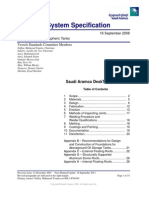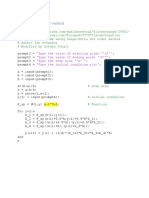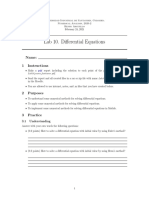Department of Chemical Engineering
Uploaded by
Shahansha HumayunDepartment of Chemical Engineering
Uploaded by
Shahansha HumayunDepartment of Chemical Engineering
Assignment No. 02
Humayun Afzal CHEN18111004
Muhammad Mubashar Wahab CHEN18111007
Tahseen Ahmad CHEN18111009
Asad Khurshid CHEN18111048
Submitted to
Engr. Basit Shafique
for
Numerical Methods for Engineers Lab
Khwaja Fareed University of Engineering and
Information Technology, Rahim Yar Khan
25th February, 2021
Page 1 of 8
Runge-Kutta Method in MATLAB
Runge-Kutta Method
Runge-Kutta method is a popular iteration method of approximating solution of ordinary
differential equations. Developed around 1900 by German mathematicians. Also known as RK
method, the Runge-Kutta method is based on solution procedure of initial value problem in which
the initial conditions are known. Based on the order of differential equation, there are different
Runge-Kutta methods which are commonly referred to as: RK2, RK3, and RK4 methods.
Runge-Kutta Method Derivation
Let’s consider an initial value problem given as:
Y' = f( t, y), y(t0) = y0
where,
y is an unknown function of time t, which may be scalar or vector quantity
y' is the rate of change of y with respect to t
t0 is the initial value of t
y0 is the value of y at time t0
Let ‘h’ be the step size such that h > 0. Now, the generation term of the series can be defined as:
yn+1 = yn + h/6 * ( k1 + 2k2 + 2k3 + k4)
tn+1 = tn + h
for n = 1, 2 , 3, 4, …. such that:
k1 = f( tn, yn)
k2 = f( tn + h/2 , yn + h/2 k1 )
k3 = f( tn + h/2, yn + h/2k2)
k4 = f( tn + h, yn + hk3)
yn+1 is the Runge-Kutta method approximation of y(tn+1)
k1 is the increment which depends on the gradient of starting interval as in Euler’s
method
k2 is the increment which relies on the slope at the midpoint of the interval, k 2 = y+ h/2
* k1
k3 is also an increment based on the gradient at midpoint, k3=y+h/2*k2
k4 is again an increment whose value depends on end of the end of interval k 4 = y + hk3
Page 2 of 8
Solving an example of Runge-Kutta method in MATLAB:
Let’s analyze and solve an initial value problem using Runge-Kutta method. We have to
approximate y(1.5) using RK2 method in this problem:
y'(t) = 1 – t*y(t) ; y(0.5) = 2.5
In the following, is given the MATALB code for solving this problem:
function a = RungeKutta(df)
% asking initial conditions
df=@(t,y)1-t*y
x0 = input('Enter initial value of x : ');
y0 = input ('Enter initial value of y : ');
x1 = input( 'Enter value of x at which y is to be calculated : ');
tol = input( 'Enter desired level of accuracy in the final result : ');
%choose the order of Runge-Kutta method
r = menu ( ' Which order of Runge Kutta u want to use', ...
' 2nd order ' , ' 3rd order ' , ' 4th order ');
switch r
case 1
% calculating the value of h
n =ceil( (x1-x0)/sqrt(tol));
h = ( x1 - x0)/n;
for i = 1 : n
X(1,1) = x0; Y (1,1) = y0;
k1 = h*feval( df , X(1,i), Y(1,i));
k2 = h*feval( df , X(1,i) + h , Y(1,i) + k1);
k = 1/2* ( k1+ k2);
X( 1, i+1) = X(1,i) + h;
Y( 1 ,i+1) = Y(1,i) + k;
end
case 2
% calculating the value of h
n =ceil( (x1-x0)/nthroot(tol,3));
h = ( x1 - x0)/n;
for i = 1 : n
X(1,1) = x0; Y (1,1) = y0;
k1 = h*feval( df , X(1,i), Y(1,i));
k2 = h*feval( df , X(1,i) + h/2, Y(1,i) + k1);
k3 = h*feval( df , X(1,i) + h, Y(1,i) + k2);
k = 1/6* ( k1+ 4*k2 + k3);
X( 1, i+1) = X(1,i) + h;
Y( 1 ,i+1) = Y(1,i) + k;
end
case 3
Page 3 of 8
% calculating the value of h
n =ceil( (x1-x0)/nthroot(tol,3));
h = ( x1 - x0)/n;
for i = 1 : n
X(1,1) = x0; Y (1,1) = y0;
k1 = h*feval( df , X(1,i), Y(1,i));
k2 = h*feval( df , X(1,i) + h/2, Y(1,i) + k1);
k3 = h*feval( df , X(1,i) + h/2, Y(1,i) + k2);
k4 = h*feval( df , X(1,i) + h, Y(1,i) + k3);
k = 1/6* ( k1+ 2*k2 + 2*k3 + k4);
X( 1, i+1) = X(1,i) + h;
Y( 1 ,i+1) = Y(1,i) + k;
end
end
%displaying results
fprintf( 'for x = %g \n y = %g \n' , x1,Y(1,n+1))
%displaying graph
x = 1:n+1;
y = Y(1,n+1)*ones(1,n+1) - Y(1,:);
plot(x,y,'r')
xlabel = (' no of interval ');
ylabel = ( ' Error ');
Following are the screenshots of the code written and executed in MATLAB along with graph:
Page 4 of 8
Figure 1
Figure 2
Page 5 of 8
Figure 3
Figure 4
Page 6 of 8
Output:
Figure 5
Figure 6
Page 7 of 8
Graph:
Figure 7
Page 8 of 8
You might also like
- Assignment 6.3: Z 1, Z 3, Z 3 y (X) X + XNo ratings yetAssignment 6.3: Z 1, Z 3, Z 3 y (X) X + X13 pages
- Numerical Solution of Initial-Value Problems 4.3 Runge-Kutta MethodNo ratings yetNumerical Solution of Initial-Value Problems 4.3 Runge-Kutta Method9 pages
- Chapter 4 Dfggdgddgdfgdfddgfdefzeffreferfsrfe: Numerical Solution of Initial-Value Problems 4.3 Runge-Kutta MethodNo ratings yetChapter 4 Dfggdgddgdfgdfddgfdefzeffreferfsrfe: Numerical Solution of Initial-Value Problems 4.3 Runge-Kutta Method8 pages
- Chapter 4 Eerrrezzerzrzerzdfggdgddgdfgdfddgfdefzeffrefer FsrfeNo ratings yetChapter 4 Eerrrezzerzrzerzdfggdgddgdfgdfddgfdefzeffrefer Fsrfe8 pages
- Chapter 4 Ffffffeerrrezzerzrzerzdfggdgddgdfgdfddgfdefzeffr EfessffdssdrfsrfeNo ratings yetChapter 4 Ffffffeerrrezzerzrzerzdfggdgddgdfgdfddgfdefzeffr Efessffdssdrfsrfe8 pages
- Numerical Solution of Second Order Ordinary Differential Equation Using Fourth Order Runge-Kutta MethodNo ratings yetNumerical Solution of Second Order Ordinary Differential Equation Using Fourth Order Runge-Kutta Method6 pages
- Runge-Kutta Method - Encyclopedia of MathematicsNo ratings yetRunge-Kutta Method - Encyclopedia of Mathematics3 pages
- Numerical Methods For Differential Equations: Euler MethodNo ratings yetNumerical Methods For Differential Equations: Euler Method27 pages
- Runge-Kutta Method (May 2020) : Santiago Rojas Alfonso COD 69637 Jhon Alejandro Cardona Giraldo COD 70390No ratings yetRunge-Kutta Method (May 2020) : Santiago Rojas Alfonso COD 69637 Jhon Alejandro Cardona Giraldo COD 703902 pages
- Lecture12 - Initial Value Problem Runge Kutta MethodsNo ratings yetLecture12 - Initial Value Problem Runge Kutta Methods26 pages
- EEP312 Chapter 7 Numerical Solutions of Differential EquationsNo ratings yetEEP312 Chapter 7 Numerical Solutions of Differential Equations20 pages
- Numerical Solutions of Nonlinear Ordinary DifferenNo ratings yetNumerical Solutions of Nonlinear Ordinary Differen8 pages
- Lab 10. Differential Equations: Name: 1 InstructionsNo ratings yetLab 10. Differential Equations: Name: 1 Instructions3 pages
- Runge-Kutta Methods - Wikipedia, The Free EncyclopediaNo ratings yetRunge-Kutta Methods - Wikipedia, The Free Encyclopedia8 pages
- Digital Signal and Image Processing using MATLAB, Volume 3: Advances and Applications, The Stochastic CaseFrom EverandDigital Signal and Image Processing using MATLAB, Volume 3: Advances and Applications, The Stochastic Case3/5 (1)
- Importing and Exporting Data: Lab Session 07No ratings yetImporting and Exporting Data: Lab Session 078 pages
- Solving An Equation With One Variable: Lab Session 12No ratings yetSolving An Equation With One Variable: Lab Session 1213 pages
- Lab Session 08: Relational and Logical OperatorsNo ratings yetLab Session 08: Relational and Logical Operators5 pages
- Lab Session 02: Defining Scalar VariablesNo ratings yetLab Session 02: Defining Scalar Variables14 pages
- Class 12 Physics 2023-24 Notes Chapter 2 - Electrostatic Potential and CapacitanceNo ratings yetClass 12 Physics 2023-24 Notes Chapter 2 - Electrostatic Potential and Capacitance32 pages
- (Ebook PDF) Synchronized Phasor Measurements and Their Applications 2nd edition by Arun Phadke, James Thorp 331950584X 9783319505848 full chapters - The ebook is now available, just one click to start reading100% (5)(Ebook PDF) Synchronized Phasor Measurements and Their Applications 2nd edition by Arun Phadke, James Thorp 331950584X 9783319505848 full chapters - The ebook is now available, just one click to start reading81 pages
- Đề Thi Thử Lần 5- Theo Form Minh Họa 2025- Biên Soạn Cô Phạm Liễu- Ngày 22122024No ratings yetĐề Thi Thử Lần 5- Theo Form Minh Họa 2025- Biên Soạn Cô Phạm Liễu- Ngày 221220246 pages
- Government of Pakistan Ministry of Defence Production Pakistan Ordnance Factories Board Wah Cantt Job OpportunitiesNo ratings yetGovernment of Pakistan Ministry of Defence Production Pakistan Ordnance Factories Board Wah Cantt Job Opportunities5 pages
- Niir Directory Database List Small Medium Enterprises Sme in Coimbatore Tamil Nadu 5th EditionNo ratings yetNiir Directory Database List Small Medium Enterprises Sme in Coimbatore Tamil Nadu 5th Edition2 pages
- Dcam PT 66 Training Module 15.10 Lubrication Systems PDFNo ratings yetDcam PT 66 Training Module 15.10 Lubrication Systems PDF73 pages
- Well Control Equipment Pre-Audit Checklist: No No Yes100% (1)Well Control Equipment Pre-Audit Checklist: No No Yes1 page
- Lecture 16: The Adiabatic Approximation: Introduction (11/10/2005)No ratings yetLecture 16: The Adiabatic Approximation: Introduction (11/10/2005)6 pages
- Kidde Bulletin 2023-02K - Fluoroketone-Based SuppressantsNo ratings yetKidde Bulletin 2023-02K - Fluoroketone-Based Suppressants1 page
- Revenue_Leakage_Guide_Consultation_pdf_1728535235No ratings yetRevenue_Leakage_Guide_Consultation_pdf_17285352357 pages
- Public Intellectuals Against The Neoliberal UniversityNo ratings yetPublic Intellectuals Against The Neoliberal University19 pages
- Free Templates: Insert The Subtitle of Your PresentationNo ratings yetFree Templates: Insert The Subtitle of Your Presentation54 pages
































































































